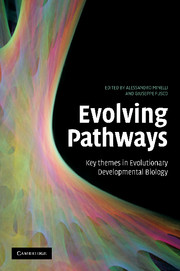Book contents
- Frontmatter
- Contents
- Contributors
- Preface
- Introduction: Pathways of change
- Part I Thinking about evolution by taking development on board
- Part II Evo-devo: methods and materials
- Part III Evolving diversity
- Part IV Evolving body features
- 17 Urbisexuality: the evolution of bilaterian germ cell specification and reproductive systems
- 18 Thoughts and speculations on the ancestral arthropod segmentation pathway
- 19 Evolution of neurogenesis in arthropods
- 20 Arthropod appendages: a prime example for the evolution of morphological diversity and innovation
- 21 Ontogeny of the spiralian brain
- Index
- References
21 - Ontogeny of the spiralian brain
Published online by Cambridge University Press: 08 August 2009
- Frontmatter
- Contents
- Contributors
- Preface
- Introduction: Pathways of change
- Part I Thinking about evolution by taking development on board
- Part II Evo-devo: methods and materials
- Part III Evolving diversity
- Part IV Evolving body features
- 17 Urbisexuality: the evolution of bilaterian germ cell specification and reproductive systems
- 18 Thoughts and speculations on the ancestral arthropod segmentation pathway
- 19 Evolution of neurogenesis in arthropods
- 20 Arthropod appendages: a prime example for the evolution of morphological diversity and innovation
- 21 Ontogeny of the spiralian brain
- Index
- References
Summary
Spiral cleavage is a characteristic feature of several protostomian taxa, sometimes united as Spiralia (Dohle 1996), but its presence in a number of these groups has been debated. This could be the result of too vague definitions, so I will emphasise here the presence of both a spiral pattern with shifting direction of the spindles in the early cleavages and a cell lineage including prototroch cells (trochoblasts) differentiating from cells along the border between first and second micromere quartet. This automatically excludes the non-ciliated groups, but their cleavage types could be discussed in the light of the conclusions reached here.
The cleavage pattern defines two regions of the larvae: the episphere, consisting of cells from the first micromere quartet, including the primary and accessory trochoblasts, and the hyposphere ‘below’ the prototroch (Figures 21.1 and 21.2). The origin of different parts of the central nervous systems from these two regions has been documented sporadically in a number of older papers on embryology of various species, and some more recent studies provide information obtained by modern methods including cell labelling. The literature on cell lineage up to about 2004 has been summarised earlier (Nielsen 2004, 2005a). Here I will try to update the information and to incorporate new information obtained from studies of Hox genes (see also Nielsen 2005b), with special emphasis on the origin of the nervous system.
- Type
- Chapter
- Information
- Evolving PathwaysKey Themes in Evolutionary Developmental Biology, pp. 399 - 416Publisher: Cambridge University PressPrint publication year: 2008
References
- 5
- Cited by



